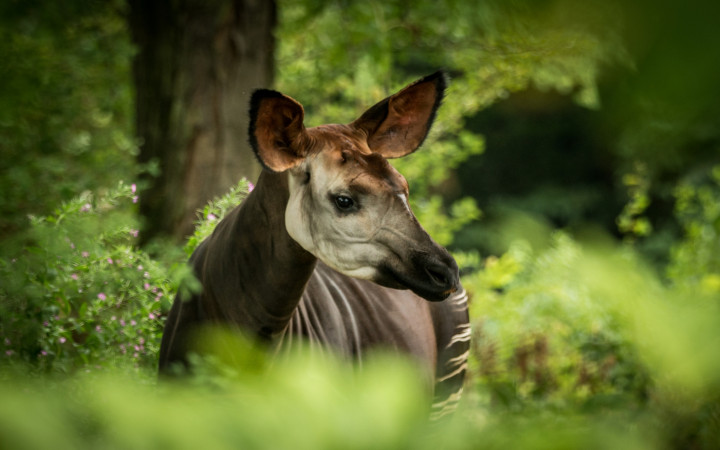Today’s Wonder of the Day was inspired by Laura from Farmington, MN. Laura Wonders, “What is an okapi?” Thanks for WONDERing with us, Laura!
Before we get into today’s Wonder of the Day, how about a riddle? Here it is: What’s black and white and red all over?
Do you know the answer? It’s a zebra with a sunburn!
Okay, one more… what’s black and white and has a giraffe cousin?
Does that one have you stumped? The answer is an animal many people haven’t heard of. But don’t worry, we’ve got you covered. Today’s Wonder of the Day is the okapi!
At first glance, you might think the okapi is a relative of the zebra. That’s because its legs are striped black and white. However, this rare animal is most closely related to its long-necked cousin, the giraffe. But okapis don’t have long necks. They aren’t as tall as giraffes, either. Fully grown, adult okapis are about five feet tall and weigh up to 770 pounds.
Why don’t okapis have long necks like giraffes? The two animals live in very different environments. While giraffes need their long legs and necks to help them reach food from tall trees on the savanna, okapis’ food is much closer to the ground.
All the okapis in the world live in the same region. You’ll find them in the rainforests of the Democratic Republic of the Congo (DRC). In these dense forests, okapis don’t have to reach as far for their food. They eat leaves from nearby branches, as well as clay and burned wood from the ground.
If you’d like to see an okapi for yourself, your best bet is to visit the zoo. In the wild, okapis are very shy. They tend to hide when they hear people coming, and their coats help okapis camouflage themselves in the rainforest. Their dark bodies are hard to see in dim light, and their striped legs often blend in with light shining through tree branches.
In fact, okapis are so good at hiding that they went unseen by scientists until 1901. Even people native to DRC rainforests rarely spot an okapi, although they do sometimes accidentally catch them in hunting traps. This makes it very difficult for scientists to measure the okapi population. Currently, they estimate it to be around 4,500.
However, okapis’ coloring does help them find each other. In fact, their stripes are sometimes called “follow me stripes.” That’s because they’re thought to help young okapis follow their mothers through the dense rainforests.
And zebra-like stripes aren’t the only interesting feature of okapis. They also have unique ears that they can move independently of each other. This helps okapis listen for sounds coming from different directions at the same time. Male okapis also have short antlers on their heads. Female okapis have small bumps on their heads, much like giraffes.
Okapis are listed as a threatened species because of their low population. However, efforts to protect their habitats and grow the population in zoos make many hopeful for this rare species. You can find this zebra look-alike in zoos across the world. What other animal look-alikes might you see while you’re there?
Standards: NGSS.LS1.A, NGSS.LS1.B, NGSS.LS1.C, NGSS.LS1.D, NGSS.LS4.C, NGSS.LS4.D, CCRA.L.3, CCRA.L.6, CCRA.R.4, CCRA.R.1, CCRA.R.2, CCRA.W.2, CCRA.L.1, CCRA.L.2, CCRA.SL.1, CCRA.SL.2, CCRA.R.10





